Fatigue Life Prediction of Reinforced Concrete Beams Strengthened with CFRP: Study Based on an Accumulative Damage Model
Abstract
:1. Introduction
2. Fatigue Life Prediction Method
2.1. Fatigue Damage of Tensile Steel Bars
2.2. Elastic Modulus Degradation of Concrete
2.3. Time-Dependent Constitutive Relationships of the Tensile Steel Bar
2.4. Equilibrium and Compatibility Equations
2.5. Procedure to Predict the Fatigue Life
- In the procedure, ni was defined as a unit of circulation and set to 10 cycles in the initial stage. In the steady stage, after 1000 cycles, ni was set to 1000 cycles. Starting the preliminary cycle, the initial elastic modulus of concrete was Ec and the constitutive relation of the first preliminary cyclic reinforcement was assumed to be linearly elastic.
- Substituting the geometric dimension, material properties of the specimens, and prestressing level of CFRP into the equilibrium equations (7)–(12), the crack height ai, the location of the neutral axis hci, the strain of the tensile steel bar, and the compressive strain at the top of the concrete at the ith cycle under the minimum and maximum loads were calculated.
- Substituting the value of the stress range applied at the tensile steel bar into Equation (3), the fatigue life and accumulated fatigue damage D of the specimen under the action of each cycle were obtained.
- If the accumulated fatigue damage D was less than 1, then the effective elastic modulus of concrete Eci after degradation could be obtained using Equation (4) and (5).
- According to the strain amplitude of the tensile steel bar in the previous step, the corresponding constitutive model in Equation (6) was selected to calculate the tensile stress of the steel bar. Then, and Eci were substituted into Equations (7)–(12) for the next cycle.
- When the accumulation of fatigue damage D = 1, the program was ended, and the fatigue life of the specimen was calculated as .
3. Fatigue Experiments under Cyclic Loading
3.1. Specimens and Materials
3.2. Prestressing System
3.3. Experimental Method
3.3.1. Testing Procedure
3.3.2. Measurements
3.4. Experimental Results
3.5. Strain Response
4. Model Verification
4.1. Crack Propagation
4.2. Fatigue Life Prediction
5. Conclusions
- The proposed accumulative damage model can well describe the crack height and stress range of tensile steel bars at different loading cycles. The fatigue lives of non-prestressed and prestressed CFRP-reinforced RC beams can also be predicted by the proposed model.
- The predicted results indicated that the predicted fatigue lives considering the gradual degradation of the concrete performance were close to the experimental data with an average relative error of 10%. However, the average relative error of predicted fatigue lives without considering the gradual degradation of concrete performance was 33%. The proposed model could accurately and reliably predict the flexural fatigue life of non-prestressed and prestressed CFRP-reinforced RC beams.
- The analysis results indicated that prestressed CFRP could decrease the stress of main steel bars in RC beams and improved the fatigue performance of the beams effectively. Compared with non-prestressed CFL-reinforced RC beams, the fatigue lives of prestressed CFL-reinforced RC beams (to a 10% prestressing level) were greatly increased.
Author Contributions
Funding
Acknowledgments
Conflicts of Interest
Abbreviations
| ai | the height of main crack at the ith cycle |
| As | cross-sectional area of tensile steel bar |
| A′s | cross-sectional area of compressive steel bar |
| Af | cross-sectional area of CFRP |
| b | the width of the RC beam |
| c | the depth of the concrete cover(measured from bottom surface of section) |
| c′ | the depth of the concrete cover(measured from top surface of section) |
| D | accumulation of fatigue damage |
| Eci | effective elastic modulus of concrete at the ith cycle |
| Ec | initial elastic modulus of concrete |
| Es | elastic modulus of the tensile steel bar |
| E′s | elastic modulus of the compressive steel bar |
| Ef | elastic modulus of the CFRP |
| fc | uniaxial compressive strength of concrete |
| fy | yield strength of the tensile steel bar |
| ft | uniaxial tensile strength of the concrete |
| h | the height of the RC beam |
| hci | the height of the tension zone for the concrete at the ith cycle at the main cracked section |
| k1, k2, k3, k4 | parameters determined by the tensile steel bar |
| M | bending moment at the main cracked section |
| ni | the cycle number for the specified stress amplitude of tensile steel bars |
| N | cycle number to fatigue failure |
| Nf | fatigue lives |
| Ni | the final cycle number to failure for the specified stress amplitude of tensile steel bars |
| Nci | the number of loading cycles to failure for concrete |
| Pmax | peak load |
| Pmin | minimum load |
| R | the stress ratio |
| Ssi | stress range applied at steel |
| Sci | maximum stress level at the ith cycle for concrete |
| yci | height of the compression zone for the concrete at the ith cycle at the main cracked section |
| maximum tensile stress of steel | |
| maximum compressive stress of concrete | |
| maximum strain of the compressive concrete at the ith cycle | |
| uniaxial tensile strain of the concrete | |
| longitudinal strain of the tensile steel bar at the ith cycle | |
| longitudinal strain of the compressive steel bar at the ith cycle | |
| initial strain of prestressed CFRP | |
| longitudinal strain of CFL at the ith cycle |
References
- Meier, U. Bridge repair with high performance composite materials. Bridge repair with high performance composite materials. Mater. Tech. 1987, 15, 125–128. [Google Scholar]
- Buyukozturk, O.; Hearing, B. Failure behavior of precracked concrete beams retrofitted with FRP. J. Compos. Constr. 1998, 2, 138–144. [Google Scholar] [CrossRef]
- Mukherjee, A.; Rai, G.L. Performance of reinforced concrete beams externally prestressed with fiber composites. Constr. Build. Mater. 2009, 23, 822–828. [Google Scholar] [CrossRef]
- Wight, R.G.; Erki, M.A. Prestressed CFRP sheets for strengthening concrete slabs in fatigue. Adv. Struct. Eng. 2003, 6, 175–182. [Google Scholar] [CrossRef]
- Wight, R.G.; Green, M.F.; Erki, M.A. Prestressed FRP sheets for poststrengthening reinforced concrete beams. J. Compos. Constr. 2001, 5, 214–220. [Google Scholar] [CrossRef]
- Larson, K.H.; Peterman, R.J.; Rasheed, H.A. Strength-fatigue behavior of fiber reinforced polymer strengthened prestressed concrete T-beams. J. Compos. Constr. 2005, 9, 313–326. [Google Scholar] [CrossRef]
- Ghafoori, E.; Motavalli, M.; Botsis, J.; Herwig, A.; Galli, M. Fatigue strengthening of damaged metallic beams using prestressed unbonded and bonded CFRP plates. Int. J. Fatigue 2012, 44, 303–315. [Google Scholar] [CrossRef]
- EI-Hacha, R.; Aly, M.Y.E. Anchorage system to prestress FRP laminates for flexural strengthening of steel-concrete composite girders. J. Compos. Constr. 2013, 17, 324–335. [Google Scholar] [CrossRef]
- Xie, J.H.; Huang, P.Y.; Guo, Y.C. Fatigue behavior of reinforce concrete beams strengthened with prestressed fiber reinforced polymer. Constr. Build. Mater. 2012, 149–157. [Google Scholar] [CrossRef]
- Huang, P.Y.; Liu, G.W.; Guo, X.Y. Fatigue life prediction of RC beams strengthened with prestressed CFRP under cyclic bending loads. Acta Mech. Solida Sin. 2013, 26, 46–52. [Google Scholar] [CrossRef]
- Oudah, F.; EI-Hacha, R. Analytical fatigue prediction mode of RC beams strengthened in flexure using prestressed FRP reinforcement. Eng. Struct. 2013, 46, 173–183. [Google Scholar] [CrossRef]
- Huang, H.; Wang, W.W.; Dai, J.G.; Brigham, J.C. Fatigue behavior of reinforce concrete beams strengthened with externally bonded prestressed CFRP sheets. J. Compos. Constr. 2017, 21, 1–13. [Google Scholar] [CrossRef]
- Guo, X.Y.; Yu, B.; Huang, P.Y.; Zheng, X.H.; Zhao, C. J-integral approach for main crack propagation of RC beams strengthened with prestressed CFRP under cyclic bending load. Eng. Fract. Mech. 2018, 200, 465–478. [Google Scholar] [CrossRef]
- Park, H.B.; Park, J.-S.; Kang, J.-Y.; Jung, W.-T. Fatigue Behavior of Concrete Beam with Prestressed Near-Surface Mounted CFRP Reinforcement According to the Strength and Developed Length. Materials 2019, 12, 51. [Google Scholar] [CrossRef] [PubMed]
- Hanif, A.; Usman, M.; Lu, Z.; Cheng, Y.; Li, Z. Flexural Fatigue Behaviour of Thin Laminated Cementitious Composites Incorporating Cenosphere Fillers. Mater. Des. 2018, 140, 267–277. [Google Scholar] [CrossRef]
- Hanif, A.; Kim, Y.; Park, C. Numerical Validation of Two-Parameter Weibull Model for Assessing Failure Fatigue Lives of Laminated Cementitious Composites—Comparative Assessment of Modeling Approaches. Materials 2019, 12, 110. [Google Scholar] [CrossRef]
- Holmen, J.O. Fatigue of Concrete by Constant and Variable Amplitude Loading; Fatigue of Concrete Structures, ACI Special Publication 75; American Concrete Institute: Detroit, MI, USA, 1982; pp. 71–110. [Google Scholar]
- Meier, U.; Nishibayashi, S.; Kuroda, T.; Omata, F. Fatigue strength and deformation characteristics of reinforced concrete beams strengthened with carbon fiber-reinforce plastic plate. Trans. Jpn. Concr. Inst. 1995, 17, 149–156. [Google Scholar]
- Heffernan, P.J.; Erki, M.A. Fatigue behavior of reinforced concrete beams strengthened with carbon fiber reinforced plastic laminates. J. Compos. Constr. 2004, 8, 132–140. [Google Scholar] [CrossRef]
- Aidoo, J.; Harries, K.A.; Petrou, M.F. Fatigue behavior of carbon fiber reinforced polymer-strengthened reinforce concrete bridge girder. J. Compos. Constr. 2004, 8, 501–509. [Google Scholar] [CrossRef]
- Meier, U. Cumulative damage in fatigue. J. Appl. Mech. 1995, 67, 159–164. [Google Scholar]
- Wang, X.; Ahamed, M.S.; Wu, Z.S. Modeling of the flexural fatigue capacity of RC beams strengthened with FRP sheets based on finite-element simulation. J. Struct. Eng. 2015, 141, 04014189. [Google Scholar] [CrossRef]
- Oudah, F.; EI-Hacha, R. Research progress on the fatigue performance of RC beams strengthened in flexure using fiber reinforced polymers. Compos. Part B Eng. 2013, 47, 82–95. [Google Scholar] [CrossRef]
- Diab, H.; Wu, Z. Review of existing fatigue results of beams externally strengthened with FRP laminates. In Proceedings of the 4th International conference on FRP Composites in Civil Engineering(CICE2008), Zurich, Switzerland, 22–24 July 2008; Swiss Federal Laboratories for Materials Science and Technology (EMPA): Duebendorf, Switzerland, 2008. [Google Scholar]
- Moss, D.S. Bending Fatigue of High-Yield Reinforcing Bars in Concrete; TRRL Supplementary Rep.748; Transport and Road Research Laboratory: Crowthome, UK, 1982. [Google Scholar]
- Holmen, J.O. Fatigue of Concrete by Constant and Variable Amplitude Loading. Fatigue Concrete Structures; American Concrete Institute: Farmington Hills, MI, USA, 1982. [Google Scholar]
- EI-Tawil, S.; Ogunc, C.; Okeil, A.; Shahawy, M. Static and fatigue analyses of RC beams strengthened with CFRP laminates. J. Compos. Constr. 2001, 5, 258–267. [Google Scholar] [CrossRef]
- Song, Y.P.; Wang, H.L.; Jia, J.Q. Behavior of concrete under multi-axial fatigue loading. J. Build. Struct. 2008, 29, 260–265. [Google Scholar] [CrossRef]
- Esmaeily, A.; Xiao, Y. Behavior of reinforced concrete columns under variable axial loads: Analysis. ACI Struct. J. 2005, 102, 736–744. [Google Scholar]
- Code for Design of Concrete Structures; GB 50010-2010; China National Standards: Shenzhen, China, 2015.
- Guo, X.Y.; Liu, D.; Huang, P.Y.; Zheng, X.H. Prestress loss of CFL in a prestressing process for strengthening RC beams. Int. J. Polym. Sci. 2017, 2017, 3832468. [Google Scholar] [CrossRef]
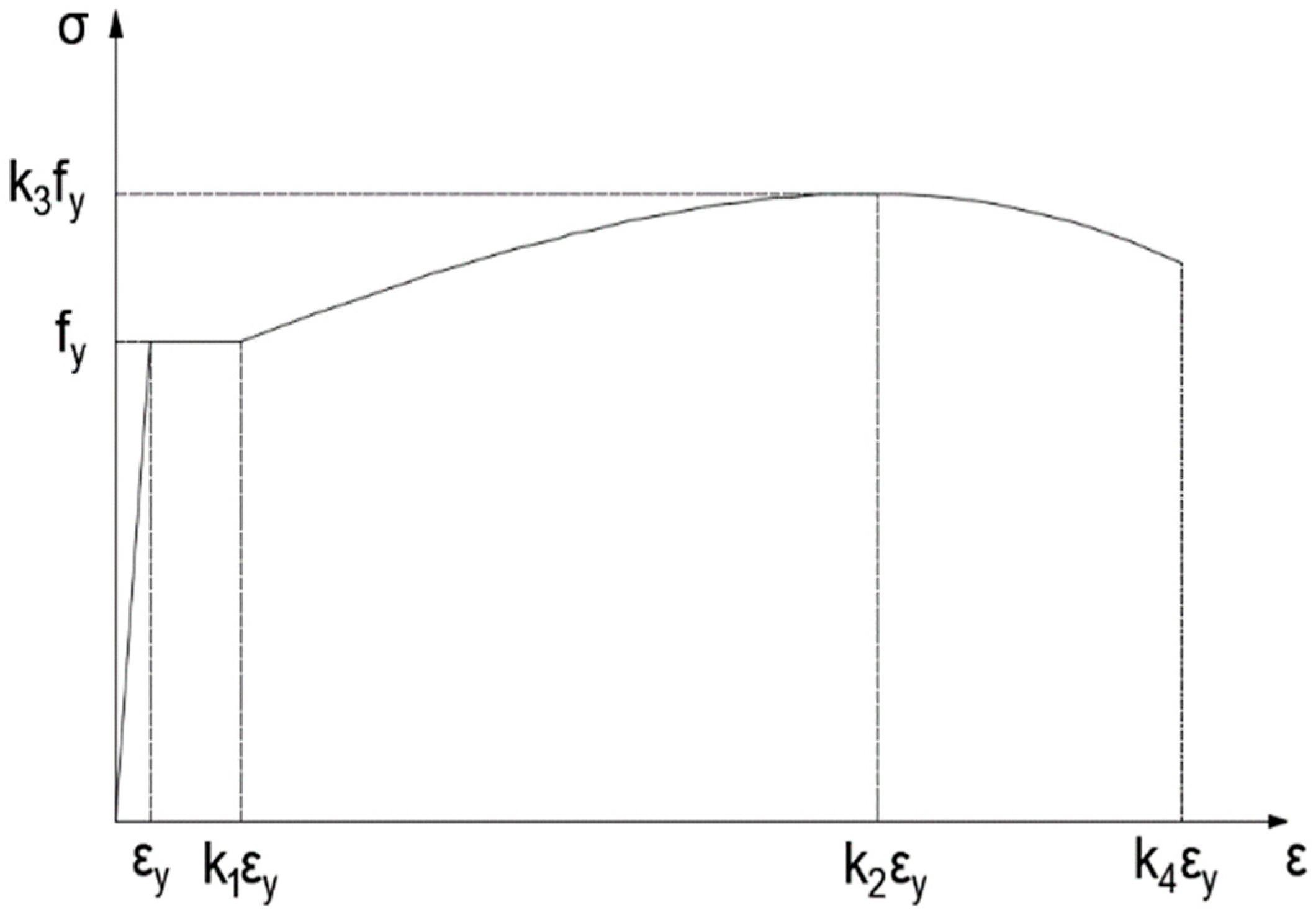
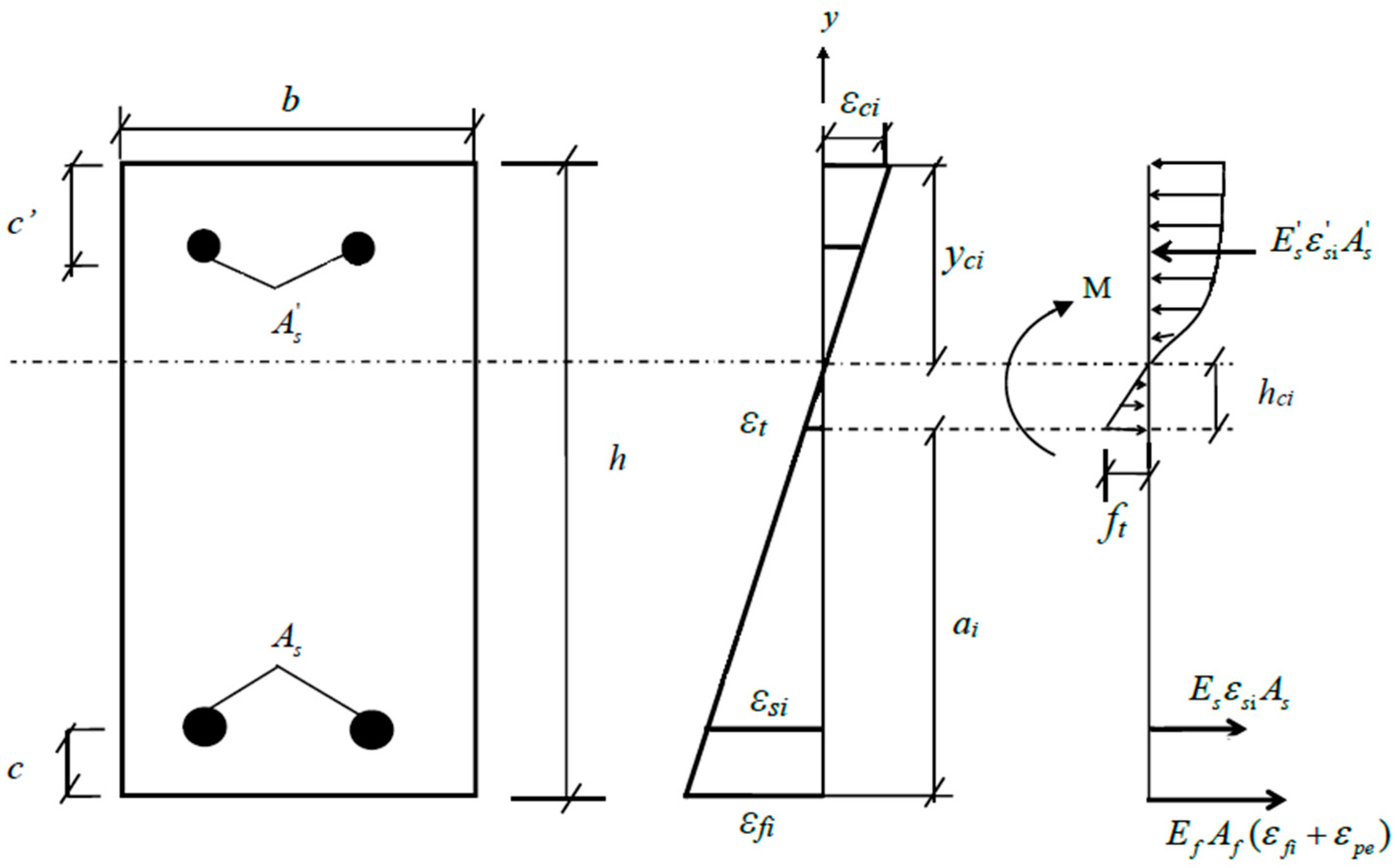
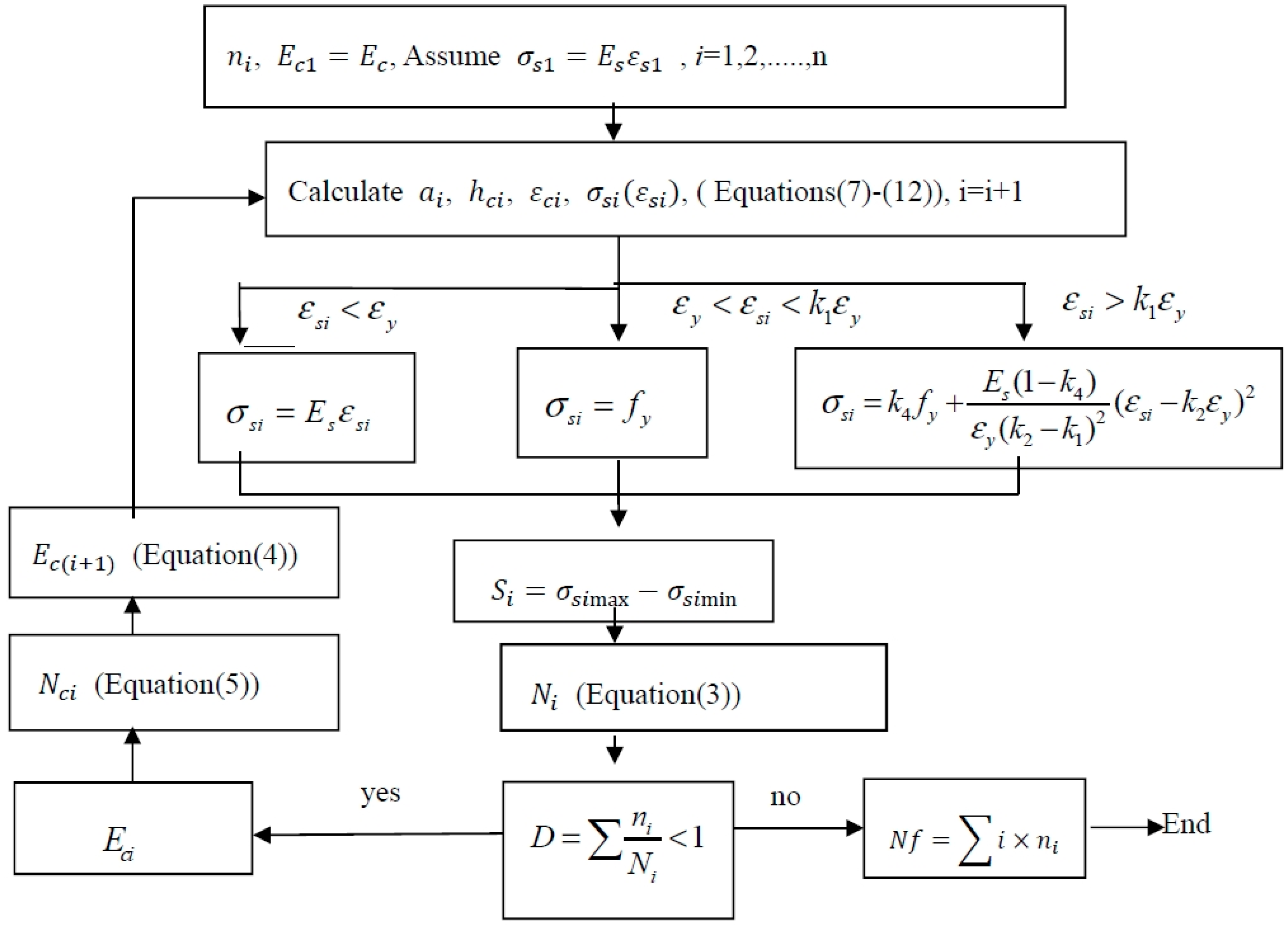


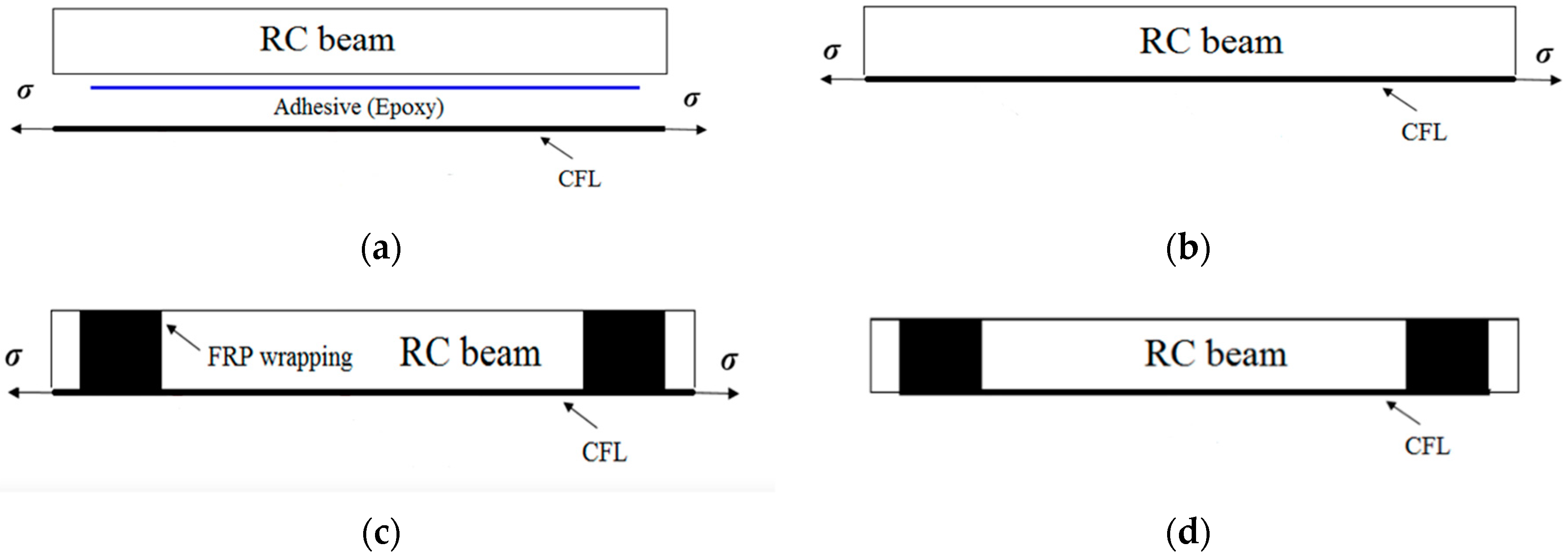



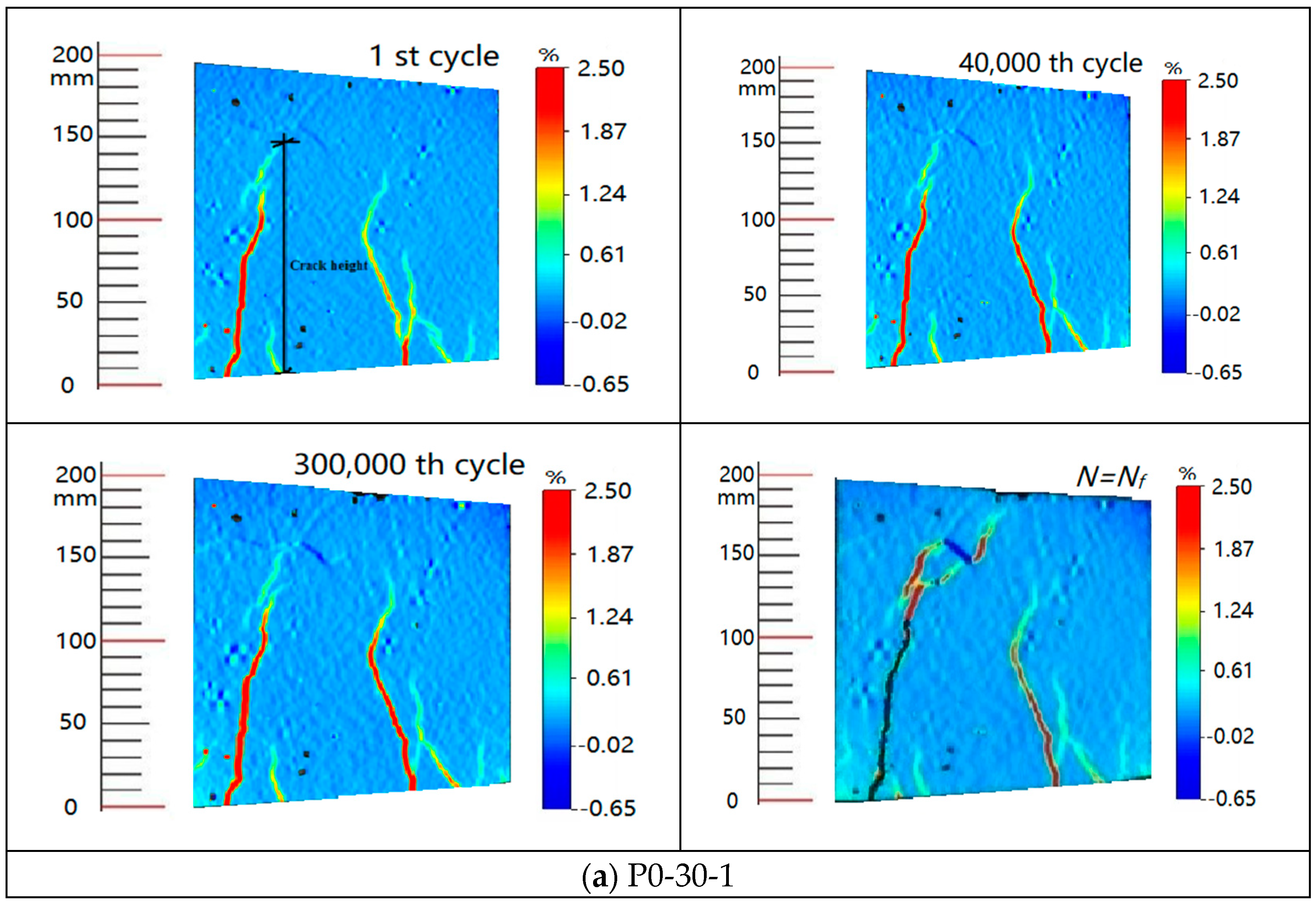





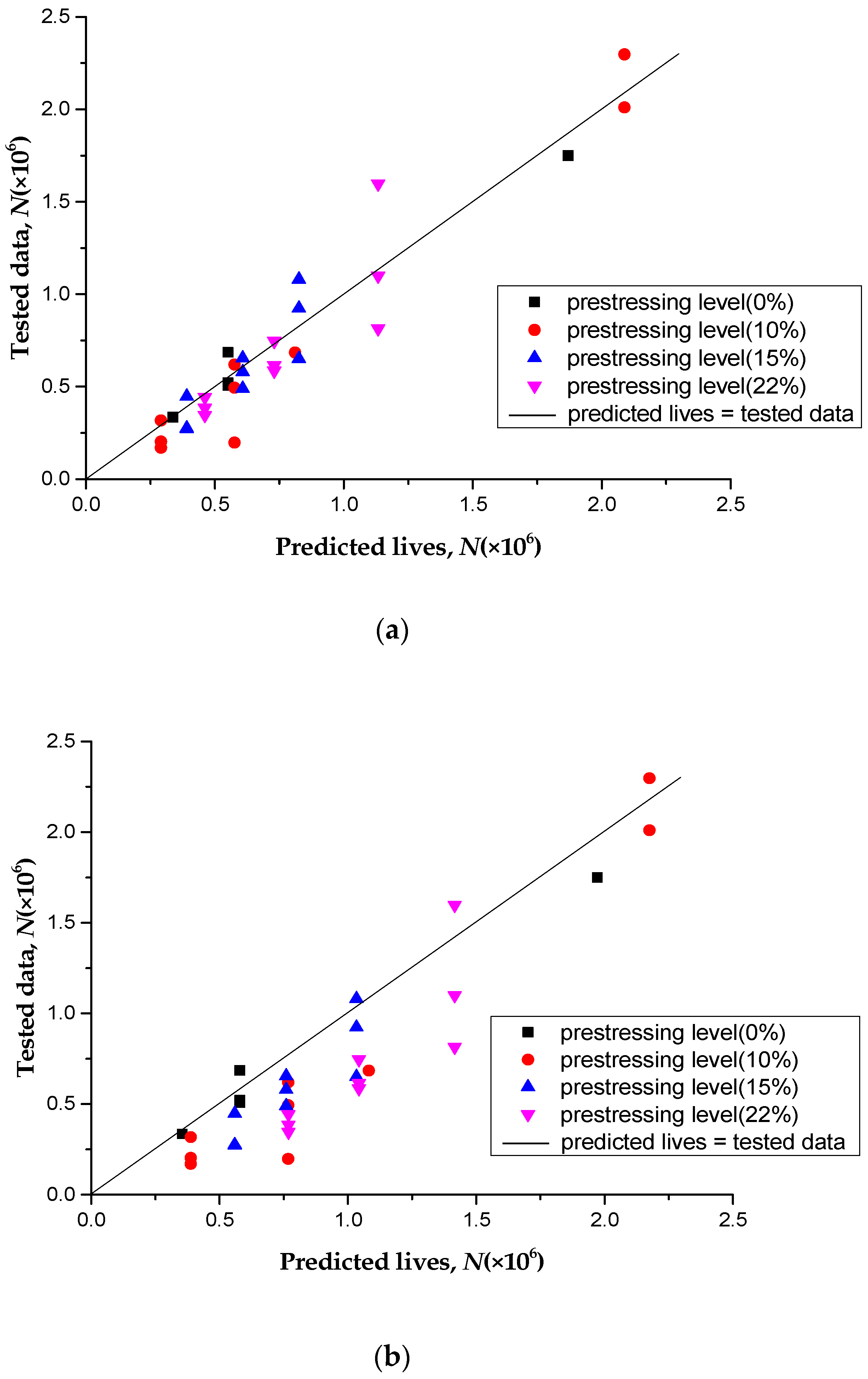
| Specimen No. | Prestressing Levels | Peak Loads, Pmax (kN) | Minimum Loads, Pmin (kN) | Initial Crack Height (mm) | Final Crack Height (mm) | Initia Steel Strain (μ) | Fatigue Lives, Nf (Cycles) |
|---|---|---|---|---|---|---|---|
| P0-25-1 | 0% | 25.0 | 5.0 | 139.9 | 148.6 | 1140.8 | 1750067 |
| P0-27.5-1 | 27.5 | 5.5 | 142.9 | 154.7 | 1467.6 | 507341 | |
| P0-27.5-2 | 141.1 | 150.9 | 1468.4 | 686534 | |||
| P0-27.5-3 | 141.2 | 149.7 | 1466.2 | 521580 | |||
| P0-30-1 | 30.0 | 6.0 | 144.0 | 159.9 | 1642.2 | 335327 | |
| P10-30-1 | 10% | 30.0 | 6.0 | 138.5 | 160.8 | 1128.6 | >2000000 |
| P10-30-2 | 136.6 | 161.0 | 1128.0 | 2296825 | |||
| P10-32.5-1 | 32.5 | 6.5 | 139.9 | 158.2 | 1249.0 | 684595 | |
| P10-35-1 | 35.0 | 7.0 | 140.3 | 161.0 | 1368.7 | 494496 | |
| P10-35-2 | 137.4 | 154.2 | 1368.1 | 197776 | |||
| P10-35-3 | 137.6 | 161.7 | 1369.4 | 620020 | |||
| P10-40-1 | 40.0 | 8.0 | 136.1 | 161.5 | 1609.2 | 203074 | |
| P10-40-2 | 141.8 | 164.6 | 1607.6 | 317900 | |||
| P10-40-3 | 141.1 | 165.0 | 1609.9 | 169990 |
© 2019 by the authors. Licensee MDPI, Basel, Switzerland. This article is an open access article distributed under the terms and conditions of the Creative Commons Attribution (CC BY) license (http://creativecommons.org/licenses/by/4.0/).
Share and Cite
Guo, X.-Y.; Wang, Y.-L.; Huang, P.-Y.; Zheng, X.-H.; Yang, Y. Fatigue Life Prediction of Reinforced Concrete Beams Strengthened with CFRP: Study Based on an Accumulative Damage Model. Polymers 2019, 11, 130. https://doi.org/10.3390/polym11010130
Guo X-Y, Wang Y-L, Huang P-Y, Zheng X-H, Yang Y. Fatigue Life Prediction of Reinforced Concrete Beams Strengthened with CFRP: Study Based on an Accumulative Damage Model. Polymers. 2019; 11(1):130. https://doi.org/10.3390/polym11010130
Chicago/Turabian StyleGuo, Xin-Yan, Yi-Lin Wang, Pei-Yan Huang, Xiao-Hong Zheng, and Yi Yang. 2019. "Fatigue Life Prediction of Reinforced Concrete Beams Strengthened with CFRP: Study Based on an Accumulative Damage Model" Polymers 11, no. 1: 130. https://doi.org/10.3390/polym11010130






